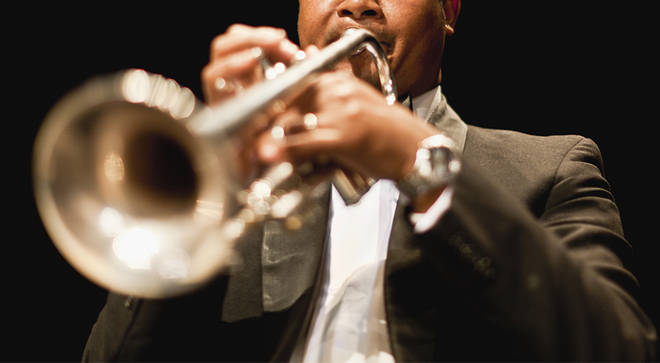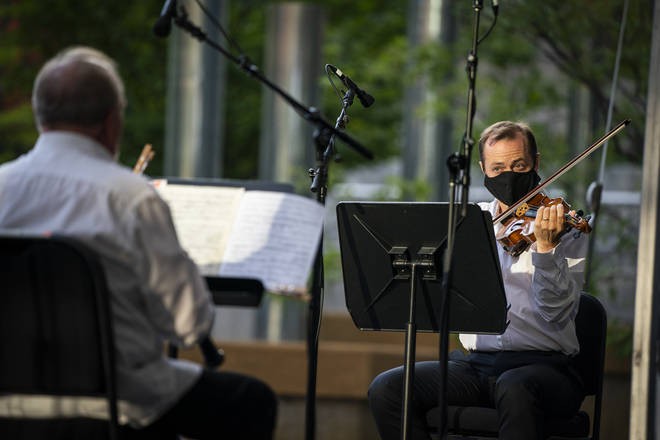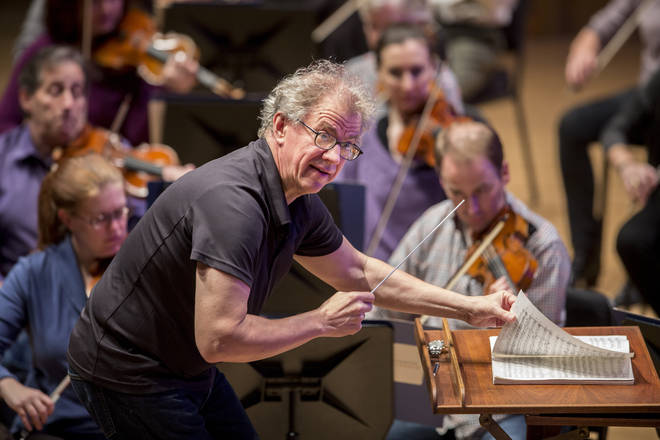It's all about the classical music composers and their works from the last 400 years and much more about music. Hier erfahren Sie alles über die klassischen Komponisten und ihre Meisterwerke der letzten vierhundert Jahre und vieles mehr über Klassische Musik.
Total Pageviews
Tuesday, November 10, 2020
Sunday, November 8, 2020
Niño Tiro - his music and his life
Niño Tiro (*1980)
Niño Tiro's music is anachronistic, eccentric, and outright melodic. Born in Cagayan de
Oro City, Philippines, he started piano lessons at the age of five. During his High-School
days, he then explored Rock and played electric bass in a band. Realizing his passion
for music regardless of genre, he pursued playing the piano for his Bachelor's degree in
music while playing Jazz and Rock during his spare time. He also taught piano in a
family-owned studio while pursuing his Bachelor's degree. After he graduated, he was
faculty of the Lourdes College School of Music for 13 years, where he became a
prestigious piano pedagogue and an avant-garde music teacher. He also plays Jazz,
Blues, and Rock as a professional session player in various local bands. In 2004, his
band's song was a radio hit and was #1 for eight weeks on the local airwaves. He
worked in the United States as The Life Teen Music Director in Santa Barbara Catholic
Church. He is currently pursuing a second Bachelor's degree in Music, majoring in
Composition under the tutelage of Horst-Hans Bäcker. He is presently faculty of The
Conservatory of Music, Theater, and Dance of Liceo de Cagayan University, the
Principal Double bass player of the Cagayan De Oro Symphony Orchestra, continuing his passion for
teaching and making music.
"Phantasie für Ludwig"; by Philippine composer Niño Tiro (*1980) is dedicated to Susanne
Kessel.
It is part of Vol. 9 of Susanne Kessel's global composition project "250 piano pieces for
Beethoven".
Susanne Kessel invited 250 composers worldwide to write new piano pieces for Beethoven's
250th anniversary in the year 2020. All pieces refer to Beethoven's music and his life.
Susanne Kessel played the world premieres of all the piano pieces in Beethoven's birth town,
Bonn. There will be more performances also in other cities and countries by the pianist herself.
All pieces are published within a high-quality sheet music edition by EDITIONS MUSICA
FERRUM / London.
The sheet music of this piece will be in Vol. 9 of the project's edition.
All information about the project - and SHOP:
www.250-piano-pieces-for-beethoven.com
"Phantasie für Ludwig"; is a Sturm und Drang piece in A minor based on the Beethoven style of
Classical Romantic composition. There are a few nods here and there from the Meister's
monumental works. The dissonance and melodic and harmonic tension in this piece conveys the
ups and downs of a composer's life and depicts the life of Ludwig succumbing to the frailty of
the human mind and body. The work ends in A, neither major and minor, symbolizing the
continuing struggles that everyone, especially Ludwig, faced in life.
Thursday, November 5, 2020
Scientists find the amazing reason your favorite music gives you ‘chills’

By Maddy Shaw Roberts, ClassicFM London
 |  |
Now we know why our favorite music sends shivers down our spine.
Scientists say they have discovered why the melodies we love give us goosebumps.
A team of French researchers found that when we listen to our favourite music, the areas of the brain which handle emotion, movement, and processing music and sound work together to create a surge in dopamine levels – our ‘feel good’ chemical.
According to the study, our brains also try to anticipate what happens next in the song. And when we guess correctly, we get a reward.
Thibault Chabin, a PhD student at the University Burgundy Franche-Comté who led the study, said: “What is most intriguing is that music seems to have no biological benefit to us. However, the implication of dopamine and of the reward system in processing of musical pleasure suggests an ancestral function for music.
“This ancestral function may lie in the period of time we spend in anticipation of the ‘chill-inducing’ part of the music. As we wait, our brains are busy predicting the future and release dopamine.
“Evolutionarily speaking, being able to predict what will happen next is essential for survival.”
Read more: Music takes 13 minutes to ‘release sadness’ and 9 to make you happy >
The team of researchers, whose study was published in the journal Frontiers in Neuroscience, carried out the experiment on 18 music-lovers with a range of musical abilities, who had all experienced chills when listening to music.
“Participants of our study were able to precisely indicate ‘chill-producing’ moments in the songs, but most musical chills occurred in many parts of the extracts and not only in the predicted moments,” says Chabin.
Side note, interestingly – or tragically, depending on your take! – only about half of people get chills when listening to music. Those who do, are considered to have an “enhanced ability to experience intense emotions”.
For Chabin’s study, the participants were hooked up to machines that record electrical activity in the brain, and they were played 90-second clips of their favourite songs.
While they were listening, the scientists watched what happened in their brains whenever the music gave them ‘chills’.
These regions work together to process music and release the ‘feel-good’ hormone, dopamine. Combined with the anticipation that triggers those pleasurable ‘reward systems’, this produces the tingly chill participants felt while listening.
“This represents a good perspective for musical emotion research,” Chabin said.
“Musical pleasure is a very interesting phenomenon that deserves to be investigated further, in order to understand why music is rewarding and unlock why music is essential in human lives.”
(C) 2020 by ClassicFM London
Sunday, October 25, 2020
Fantasia on Smoke on the Water
Thursday, October 22, 2020
US orchestra study finds trumpet ‘riskiest’ instrument for spreading COVID-19

By Maddy Shaw Roberts, ClassicFM
 |  |
A University of Minnesota study discovers the wind instruments that emit the most aerosols, and are therefore “riskiest” in the transmission of COVID-19.
Trumpets and oboes, as well as bass trombones, were found to be “high risk” compared to other brass and woodwind instruments, in new research into coronavirus transmission in orchestras.
Bass clarinet and tuba were found to be “lower risk”.
Researchers from the University of Minnesota found that while trumpets and oboes were the “riskiest” instruments for transmitting airborne diseases, none of the examined wind instruments were found to spread aerosols further than one foot.
Published last month in the Journal of Aerosol Science, the study investigated 15 musicians from the Minnesota Orchestra in an effort to help them return to live music-making in a COVID-secure way.
Researchers say their findings could provide “valuable insights into the risk assessment of airborne disease transmission and the corresponding mitigation strategies for different musical activities involving the usage of wind instruments”.
Read more: UK government’s latest guidance for live music-making >

In the study, researchers tracked the aerosols emitted from 10 orchestral woodwind and brass instruments: the flute, piccolo, bass clarinet, oboe and bassoon; tuba, French horn, trumpet, trombone and bass trombone.
The concentration of aerosols – tiny air particles that can contain viruses and lead to the transmission of airborne diseases like COVID-19 – produced from instruments, was then compared with the amount produced by players when simply breathing or speaking.
Read more: Singing ‘no riskier than talking’, UK study says >
“As higher aerosol concentration leads to an increased risk of airborne disease transmission, we categorise these instruments into low, intermediate, and high-risk levels,” researchers said.
The aerosols coming from instruments ranged from 20 to 2,400 particles per litre of air. When players were tested when breathing or speaking, they produced an average of just 90 and 230 particles per litre respectively.
Trumpet, oboe and bass trombone players, in particular, were likely to produce more aerosols when playing, than while speaking and breathing. The researches termed these instruments “high risk” for transmitting airborne diseases.
The bassoon, piccolo, flute, bass clarinet and French horn were considered an “intermediate risk”.
Perhaps due to the tube length of the instrument, the tuba was termed “low risk”.
Scientists said mouthpiece designs could also affect the level of aerosols produced.
“All of this information I think is very useful for planning,” said Department of Mechanical Engineering Associate Professor Jiarong Hong, who led the team. “Once we understand the risk level of different instruments, we can actually target the higher risk instruments. You certainly don’t want to have a group of trumpet players playing in a confined room because that will be a very high-risk activity.”

University of Hong Kong microbiologist Dr Ho Pak-leung said the study could influence orchestral seating arrangements going forward, as the arts world looks for ways to perform live safely in pandemic times.
“Those wearing masks could sit closer, while those who can’t wear masks should sit further apart,” Ho said, adding that a distance of 1.5 metres (4.9 feet) between unmasked players would be safer.
Ho said plastic screens between players could help block some big droplets, but attested that good ventilation is still crucial in reducing the risk of transmission through tiny particles.
Researchers also recommended social distancing, putting masks over instruments and using portable filters. They found that a single-layer mask blocks 60 percent of the particles without significantly reducing sound quality. Two layers block 75 percent with a slight drop in sound quality, while three layers block 92 percent but cause a substantial dip in sound quality.
Minnesota Orchestra is currently performing for online audiences only, in small groups of no more than 25 musicians. The full orchestra consists of around 90 musicians.
President and CEO Michelle Miller Burns said the orchestra is now planning “a multi-layered approach to safety onstage and backstage that involves COVID testing, light quarantining, wearing masks, maintaining distance between musicians, and investigating bell barriers and air purifiers – all in the interest of mitigating as many risks as possible”.
She added: “This important research will benefit organisations beyond ours, and we are pleased that the University’s findings can now be shared with school groups and other ensembles to help inform and guide their decisions and safety strategies.”
Tuesday, October 20, 2020
Rockmusiker Spencer Davis ist tot
Bekannt wurde der britische Musiker in den 1960er Jahren mit Songs wie "Keep On Running". Nun ist SpencerDavis im Alter von 81 Jahren in Los Angeles gestorben.
Der Gründer der "Spencer Davis Group" starb in einem Krankenhaus der kalifornischen Stadt. Todesursache sei eine Lungenentzündung gewesen, teilte sein langjähriger Manager Bob Birk mit. Der 1939 in Wales geborene Spencer Davis sang, spielte Gitarre und Keyboard. Er hatte die nach ihm benannte Band 1963 gegründet, die bald mit Songs wie "Gimme Some Lovin" und "I'm a Man" Erfolge feiern konnte. "Keep On Running" und "Somebody Help Me" schafften es Mitte der 60er Jahre auf Platz eins der britischen Singlecharts. Viele weitere Titel schafften es in die britischen Top 40.
Seine Musiker-Karriere begann Davis während eines Studiums an der Universität Birmingham. Er trat zusammen mit zukünftigen Stars wie dem späteren Rolling-Stones-Bassisten Bill Wyman und dem Fleetwood Mac-Mitglied Christine McVie auf. In den 70er Jahren zog Davis nach Kalifornien, nahm später Solo-Alben auf, arbeitete mit anderen Musikern zusammen und tourte um die Welt.
Sein Manager Birk würdigte ihn als hochmoralischen, sehr talentierten, gutmütigen, extrem intelligenten und großzügigen Menschen. Davis hinterlässt seine Partnerin June und drei erwachsene Kinder.
qu/rb (dpa, ap)


